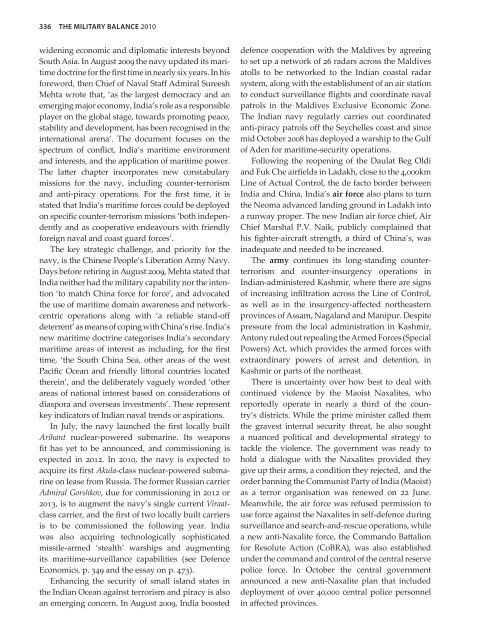Create successful ePaper yourself
Turn your PDF publications into a flip-book with our unique Google optimized e-Paper software.
336 The MiliTAry BAlAnCe 2010<br />
widening economic and diplomatic interests beyond<br />
South Asia. In August 2009 the navy updated its maritime<br />
doctrine for the first time in nearly six years. In his<br />
foreword, then Chief of Naval Staff Admiral Sureesh<br />
Mehta wrote that, ‘as the largest democracy and an<br />
emerging major economy, India’s role as a responsible<br />
player on the global stage, towards promoting peace,<br />
stability and development, has been recognised in the<br />
international arena’. The document focuses on the<br />
spectrum of conflict, India’s maritime environment<br />
and interests, and the application of maritime power.<br />
The latter chapter incorporates new constabulary<br />
missions for the navy, including counter-terrorism<br />
and anti-piracy operations. For the first time, it is<br />
stated that India’s maritime forces could be deployed<br />
on specific counter-terrorism missions ‘both independently<br />
and as cooperative endeavours with friendly<br />
foreign naval and coast guard forces’.<br />
The key strategic challenge, and priority for the<br />
navy, is the Chinese People’s Liberation Army Navy.<br />
Days before retiring in August 2009, Mehta stated that<br />
India neither had the military capability nor the intention<br />
‘to match China force for force’, and advocated<br />
the use of maritime domain awareness and networkcentric<br />
operations along with ‘a reliable stand-off<br />
deterrent’ as means of coping with China’s rise. India’s<br />
new maritime doctrine categorises India’s secondary<br />
maritime areas of interest as including, for the first<br />
time, ‘the South China Sea, other areas of the west<br />
Pacific Ocean and friendly littoral countries located<br />
therein’, and the deliberately vaguely worded ‘other<br />
areas of national interest based on considerations of<br />
diaspora and overseas investments’. These represent<br />
key indicators of Indian naval trends or aspirations.<br />
In July, the navy launched the first locally built<br />
Arihant nuclear-powered submarine. Its weapons<br />
fit has yet to be announced, and commissioning is<br />
expected in 2012. In 2010, the navy is expected to<br />
acquire its first Akula-class nuclear-powered submarine<br />
on lease from Russia. The former Russian carrier<br />
Admiral Gorshkov, due for commissioning in 2012 or<br />
2013, is to augment the navy’s single current Viraatclass<br />
carrier, and the first of two locally built carriers<br />
is to be commissioned the following year. India<br />
was also acquiring technologically sophisticated<br />
missile-armed ‘stealth’ warships and augmenting<br />
its maritime-surveillance capabilities (see Defence<br />
Economics, p. 349 and the essay on p. 473).<br />
Enhancing the security of small island states in<br />
the Indian Ocean against terrorism and piracy is also<br />
an emerging concern. In August 2009, India boosted<br />
defence cooperation with the Maldives by agreeing<br />
to set up a network of 26 radars across the Maldives<br />
atolls to be networked to the Indian coastal radar<br />
system, along with the establishment of an air station<br />
to conduct surveillance flights and coordinate naval<br />
patrols in the Maldives Exclusive Economic Zone.<br />
The Indian navy regularly carries out coordinated<br />
anti-piracy patrols off the Seychelles coast and since<br />
mid October 2008 has deployed a warship to the Gulf<br />
of Aden for maritime-security operations.<br />
Following the reopening of the Daulat Beg Oldi<br />
and Fuk Che airfields in Ladakh, close to the 4,000km<br />
Line of Actual Control, the de facto border between<br />
India and China, India’s air force also plans to turn<br />
the Neoma advanced landing ground in Ladakh into<br />
a runway proper. The new Indian air force chief, Air<br />
Chief Marshal P.V. Naik, publicly complained that<br />
his fighter-aircraft strength, a third of China’s, was<br />
inadequate and needed to be increased.<br />
The army continues its long-standing counterterrorism<br />
and counter-insurgency operations in<br />
Indian-administered Kashmir, where there are signs<br />
of increasing infiltration across the Line of Control,<br />
as well as in the insurgency-affected northeastern<br />
provinces of Assam, Nagaland and Manipur. Despite<br />
pressure from the local administration in Kashmir,<br />
Antony ruled out repealing the Armed Forces (Special<br />
Powers) Act, which provides the armed forces with<br />
extraordinary powers of arrest and detention, in<br />
Kashmir or parts of the northeast.<br />
There is uncertainty over how best to deal with<br />
continued violence by the Maoist Naxalites, who<br />
reportedly operate in nearly a third of the country’s<br />
districts. While the prime minister called them<br />
the gravest internal security threat, he also sought<br />
a nuanced political and developmental strategy to<br />
tackle the violence. The government was ready to<br />
hold a dialogue with the Naxalites provided they<br />
give up their arms, a condition they rejected, and the<br />
order banning the Communist Party of India (Maoist)<br />
as a terror organisation was renewed on 22 June.<br />
Meanwhile, the air force was refused permission to<br />
use force against the Naxalites in self-defence during<br />
surveillance and search-and-rescue operations, while<br />
a new anti-Naxalite force, the Commando Battalion<br />
for Resolute Action (CoBRA), was also established<br />
under the command and control of the central reserve<br />
police force. In October the central government<br />
announced a new anti-Naxalite plan that included<br />
deployment of over 40,000 central police personnel<br />
in affected provinces.


